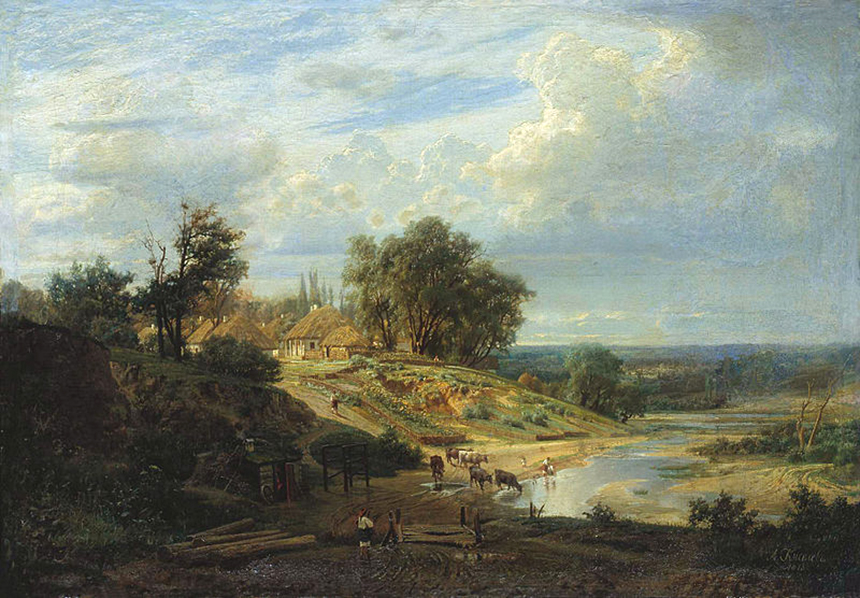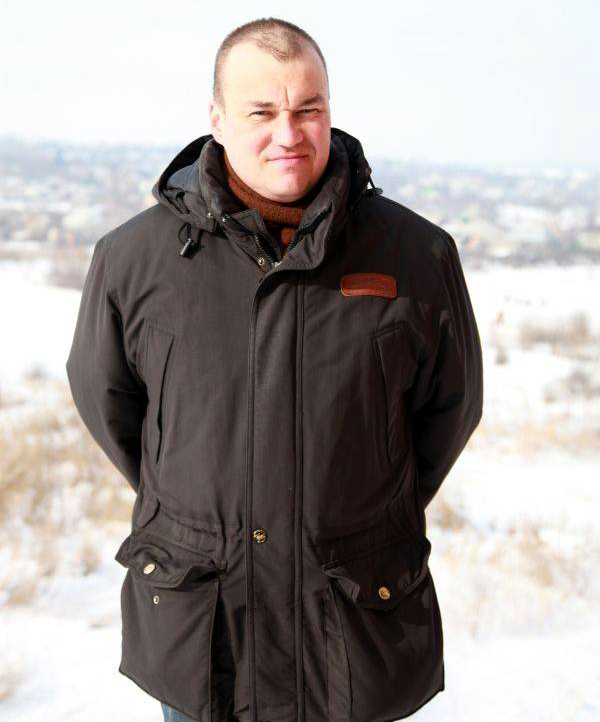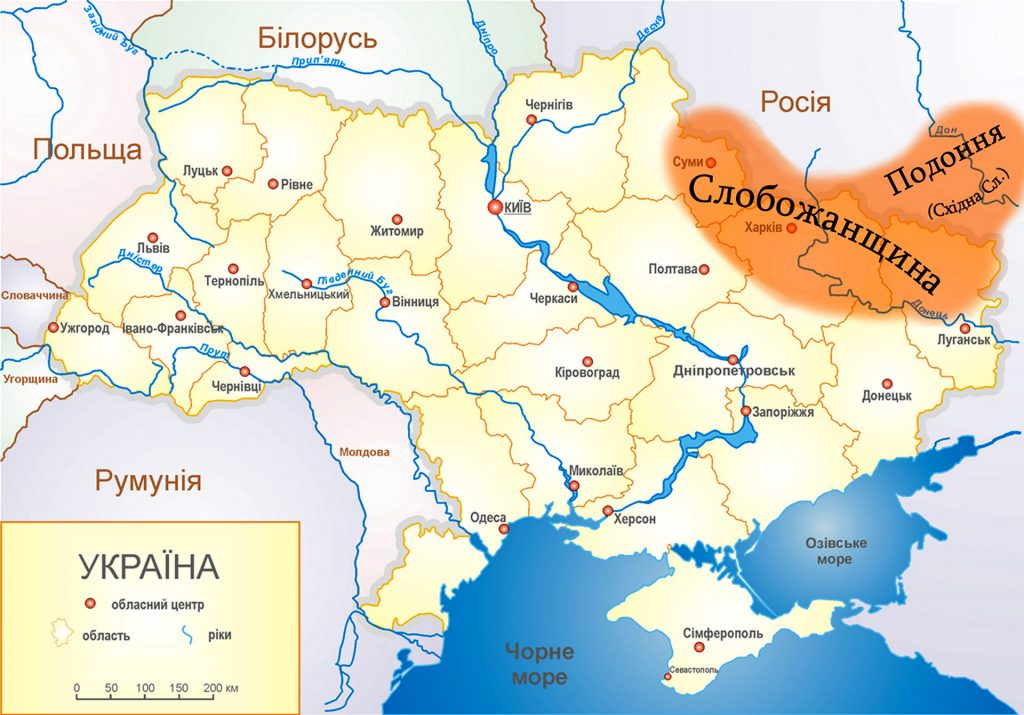Slobidska Ukraine is a region where various cultures intersected — Volodymyr Masliichuk
How important are local identities? Do they exist in Ukraine? How did people learn to coexist with each other after many years? On the latest "Encounters" program devoted to Ukrainian-Jewish relations, we talked about Slobidska Ukraine as a borderland.
"Borderland" is a word that often figures in academic research, but it can also be heard outside specialists' circles. We are beginning to reflect on who we are and what we are like, not just in general (as people of this country) but locally, as well. How are we in Transcarpathia different from or similar to people in Kharkiv or Chernihiv oblasts?
Today our conversation will be about Slobidska Ukraine. We are speaking with Volodymyr Masliichuk, author of the book U poloni prykordon′ ta naratyviv: Doslidzhennia z istoriï Slobids′koï Ukraïny XVII–XIX stolit′ (Captive to Borderlands and Narratives: A Study of the History of Slobidska Ukraine, 17th–19th Centuries). He is a Doctor of Historical Sciences, an associate professor at the National University of Kyiv-Mohyla Academy, and the editor of the website Historians.in.ua.
Those who speak the same language
Vasyl Shandro: Professor Masliichuk, when we talk about the eighteenth and nineteenth centuries, how important and definitive is the question "You and I, we and they" for people from the part of the world where we live? What do documents tell us?
Volodymyr Masliichuk: Such identification has existed since the beginnings of human existence, that is, since the beginnings of culture. Accordingly, both the eighteenth and nineteenth centuries will be marked by a certain universalization, that is, the delimitation of space. I would like to remind our listeners that the late eighteenth and early nineteenth centuries were a period marked by the great discovery of the people [narod], especially in these territories, and there is an identification that people with special customs live there. This is what later came to be known as "mapping." Historians like that word. And so it identifies a territory inhabited by people who speak the same, a similar dialect, the same language, they have customs in common and the like. In other words, this is a period of great generalization of these great things, when it is discovered that people who speak a similar language are living in quite a sizeable space. And all this took place under the slogans of the Enlightenment.
These discoveries have their roots in the early modern period, of course, because there takes place a certain "dewitching" of the world. Whereas in the past peoples, people were often divided mostly by faith, now new information is discovered, indicating that we are those who speak the same language, we have a shared history, we have a shared view of the future to a certain degree. All this is happening during this period. Of course, our territory in Europe's eastern part is not bypassed; on the contrary, it will be expressed in a very brilliant manner.

Remember that what we call modern nation-building overcomes regional boundaries. In other words, as Slobidska Ukraine is forming, it understands itself intellectually as Ukrainian territory, first and foremost, not as something very, very separate. The fact that the population base of Slobidska Ukraine — and this becomes apparent in 1918 in Dmytro Bahalii's book Istoriia Slobids′koï Ukraïny (The History of Slobidska Ukraine) — is comprised precisely of Ukrainians is emphasized. This is a very interesting period, when we see great regionalism, on the one hand, and on the other, the creation of this space, the creation of new national units that are not even new but those that are recreated there.
Vasyl Shandro: Do you mean unification, if we're talking about the period of the Ukrainian Revolution, those large areas throughout the territory of Ukraine that discovered in themselves many more things in common than not, considering that there are many such differences from the Sian to the Don rivers?
Volodymyr Masliichuk: To a certain degree. This was already established before the events of the Ukrainian Revolution, 1917–1920. It is considered a great marvel that Ukrainian-Galicians and Ukrainians from Great Ukraine created a single field, a single nation. But all these roots that we are talking about go back to a significantly earlier period, and this is very important if we are going to be talking about the self-awareness of Ukrainians, Rusyns, or Ruthenians.
The name "Ukrainians" is also interesting for our understanding of our past. This period is the "encounter of Rus' with Rus'," as Nataliia Yakovenko has written. It pertains to the Union of Lublin when the Galician lands were united with the Ukrainian lands that were part of the Grand Duchy of Lithuania. This led to an encounter between figures who, it would seem, were part of different yet very similar state creations, but they had very much in common. In other words, all these roots that we are talking about are located in the early modern period, but this period that we call modern, on the contrary, underscores all this, unifies all this, and creates general, national narratives out of it.
I will bring up one important point. It is not so much these ideologemes, which already existed — the idea of a Great Ukraine came into existence long before 1917 — that played a role. All these things were accelerated by the First World War, in whose trenches the inhabitants of various regions of the Russian Empire recognized one another. During this same period, Ukrainian national units were formed in the Austro-Hungarian Empire. In other words, this catalyst, in fact, played a huge role in the beginnings of national movements and the acquisition of national features in these territories via the Revolution of 1917 and subsequently.
Slobidska Ukraine as a borderland
Vasyl Shandro: Is it correct to call Slobidska Ukraine a "borderland"?
Volodymyr Masliichuk: It is not just correct but necessary, because it is only thanks to this method, thanks to an understanding of borderland, that we can learn the history of Slobidska Ukraine and decipher its special features that should be emphasized; all these things should be underscored.
Despite all this Ukrainianness, this is a very special region, a region that often one cannot understand. The only thing that should be emphasized is that this is a region of a great encounter, of various cultures. At the time of its settlement, it was, naturally, an encounter between Ukrainians and Russians. We should dispense with — to put it mildly — the terms "Ukrainian" and "Russian" because the names of these representatives will not be ethnic ones. In Russian documents, the settlers are very rarely called "Little Russians," although there are indeed such cases; usually they are called "Cherkasy" [the official name for Ukrainian Cossacks used in the laws and state documents of Muscovy in the sixteenth and seventeenth centuries—Trans.]. In the same way, the Great Russian, or Russian population will not be homogeneous. It will be marked by one social category or another: "boyars' sons," "people of one faith," even "Great Russian people." But these aspects are very, very important. This is a region where cultures encounter each other.
And, of course, where there is a meeting of cultures, there are not just great understandings but also great conflicts. Here one should understand that we can comprehend all kinds of understandings only in the presence of conflict, and this can hardly be denied. But Slobidska Ukraine is a brilliant example of various understandings, and this pertains to Ukrainians and Russians as well as to many other third forces that we encounter on the territory of Slobidska Ukraine, particularly the Greeks, Roma, Germans, Poles, Jews, and others. Mutual understanding and misunderstanding between two parties will be, in any case, mutual understanding and misunderstanding with a third party. A third force reconciles. A third force compels unity. These are very interesting examples, interesting points in time.
I remind you that this territory is the territory of a certain Turkicness and, of course, the interaction with the Crimean Tatars, with the Turkic-speaking world, will play a very big role later, as regards Muslim prisoners of war who were in these territories in the eighteenth and nineteenth centuries, during the numerous wars between the Russian and Ottoman empires.
Who settled the lands of Slobidska Ukraine?
Vasyl Shandro: You just named several nations that obviously had some kind of distinguishing markers. What were these markers? Was it, first and foremost, religion and language, or clothing or cultural behavior or types of occupations? Could all this define this otherness? And how was this otherness perceived? Is a moment of recognizing the other always negative or was it the other way around? Did the other reflect or separate and transform you into some kind of discrete unit that represents some majority, some kind of other whole?
Volodymyr Masliichuk: That is a very interesting question, and today I am trying to track publications, of which there are many, especially those that concern the minorities that lived in Ukraine's east. There are excellent books, excellent monographs, and collections of documents, but often the claims of the people who write these books are erroneous.
It is believed that Slobidska Ukraine was settled by people from various nations, to put it mildly. The only thing that is forgotten is that specifically during the great Cossack Revolution, despite all the positive features that we mention in connection with it, quite a homogeneous space was created in the Ukrainian territories, as we call them today. Above all, these were representatives of the Orthodox population. I remind you that the Khmelnytsky Era is known for its destruction of the Jews and the expulsions of Catholics, people of the Catholic faith. The representatives of this precise space settle on the lands in the east that are nominally under the rule of the Muscovite state, and they create this new space there.
In other words, we cannot speak of the existence in this region of some or other representatives of nationalities or ethnic groups — nationality is a later phenomenon —because above all, they had to be of the Orthodox faith. That is, initially these are Ukrainians and Russians. Only later will we see other ethnic groups. But their dependence on the Orthodox faith will be obvious; that is, they will be first and foremost Greeks, Moldovans — or Wallachians, as they were often called during this period. It is also important to recognize that these are the Roma, whom the Orthodox clergy, through its missions, perennially seeks to subjugate.
Other people, who are not Orthodox and are very different, appear here significantly later: in the eighteenth century, during the stationing here of regular Russian troops with German officers. It is fascinating that this space will be connected to events in the Balkans that take place during the second half of the seventeenth century and the beginning of the eighteenth. This is very important. That is, we shall not see either Armenians or Jews.
We have examples of Jews who converted to Christianity if you go by surnames. There is a very famous family, the Perekhrestovs, the Buhaienkos, and the Leibas. Going just by surnames, we can say that these are people who converted.
I will mention a very important point. Converts — their descendants — played a very big role in the history of Ukraine, in particular the Markevyches (Markovyches), Hertsyks, Kryzhanovskys. These are powerful figures of whom Left-Bank Ukraine can be proud.
Famous Cossack dynasties

Vasyl Shandro: These are entire large dynasties?
Volodymyr Masliichuk: Yes, their origins were Jewish. The Hertsyks and the Markevyches (Markovyches). This is an established fact, and they were often reproached on this score. And this is quite a significant point. I will remind you that Hertsyk was [Ivan] Mazepa's associate and later — [Pylyp] Orlyk's. It is very important to know that they come from Christianized families.
In Slobidska Ukraine, you have the Perekhrestov-Osipov family, which, according to its etymology, has Jewish roots. Besides etymology, there are even memoirs — not memoirs but documentary corroboration indicating that the most famous colonel of Okhtyrka, Ivan Ivanovych Perekhrestov, was a key figure in the history of the regiments in Slobidska Ukraine during the second half of the seventeenth century. His father was a convert from Judaism, Ivan Yakovych Perekhrestov, who could not endure the hardships of life in the regiments of Slobidska Ukraine and returned to Dubno, to the Jews.
Vasyl Shandro: And was this generally a pretty familiar story of such interconfessional and interethnic migrations?
Volodymyr Masliichuk: No two ways about it. I remind you that this revolutionary frenzy — Cossack, essentially — forced people either to accept Orthodoxy and thus survive, or not. But I must remind you again that, no matter how bitter and sad it is for us, if we look at the rhetoric of the Ukrainian hetmans, it is mostly very antisemitic. For example, [Vasyl] Kochubei and Iskra's well-known denunciation of Hetman Mazepa was transmitted by Yatsenko, a converted Jew from Poltava. In connection with this, Mazepa constantly emphasized that he was from that tribe, that he is a Christianized Jew, that he is not our representative. This was a label that had to be borne. In order to survive in this space, it was necessary to adopt this.
Vasyl Shandro: It is important to understand the situation that existed in Europe at the time. Did self-identified affiliation with a certain religion define how people perceived each other?
Volodymyr Masliichuk: It is difficult to talk about this because we are talking about Europe during the period of confessionalization, when one church or another, affiliation to one faith or another, is сlearly demarked. In other words, a Lutheran is a Lutheran. A Catholic is a Catholic. A Lutheran will not attend a Catholic church, a Catholic will not go to a Lutheran church, and they have certain markers. Accordingly, we will see this confessionalization happening in the Ukrainian lands following the Union of Brest or even a bit earlier, when this delineation is taking place. Nataliia Yakovenko writes about this very aptly. She characterized this as a "split world." Extraordinarily interesting. When, during the first half of the seventeenth century, very unique things are taking place but, at the same time, a person cannot identify him/herself as Orthodox or Catholic very clearly and sometimes someone who is Orthodox goes to a Catholic church, and a Catholic might enter an Orthodox church. This conflict takes place in the sixteenth and seventeenth centuries.
Vasyl Shandro: But this is internally confessional history. What about other religions? We talked about the Jewish component, for example, converts to Christianity or people who became Orthodox for various reasons. Is it possible for example to talk about Turks or Turks in this respect?
Volodymyr Masliichuk: The phenomenon of Tatars and Turks converting to Christianity is widespread. But you see what the point is, and this is also a very important moment, especially when we are talking about contact between cultures. During numerous wars, a certain number of captives appeared here. And often such captives were children, minors, who had been captured mostly by Cossacks or Cossack officers, and they were converted against their will, and then they went on to live here and continue their activities. In Slobidska Ukraine there were even important Cossack officer families, like the Tatarchuks, Turchenynovs, and Turchyns, whose surnames speak to their origins.
One of the greatest Enlighteners, Vasyl Fotiiev, was the son of a Christianized Tatar, who was acquainted with [Vasily] Karazin and was involved in many educational initiatives in Kharkiv. In other words, such instances occurred.
Vasyl Shandro: And Kochubei, whom you already mentioned.
Volodymyr Masliichuk: Of course, Kochubei had Turkic, Tatar roots. That's understandable. It cannot be denied that there was much that was Turkic about the Cossacks. The very word "Cossack" is of Turkic origin; let's acknowledge these things. The first references to Cossacks were not at all Slavic ones.
This program is created with the support of Ukrainian Jewish Encounter (UJE), a Canadian charitable non-profit organization.
Originally appeared in Ukrainian (Hromadske Radio podcast) here.
Translated from the Ukrainian by Marta D. Olynyk.
Edited by Peter Bejger.
NOTE: UJE does not necessarily endorse opinions expressed in articles and other materials published on its website and social media pages. Such materials are posted to promote discussion related to Ukrainian-Jewish interactions and relations. The website and social media pages will be places of information that reflect varied viewpoints.




















